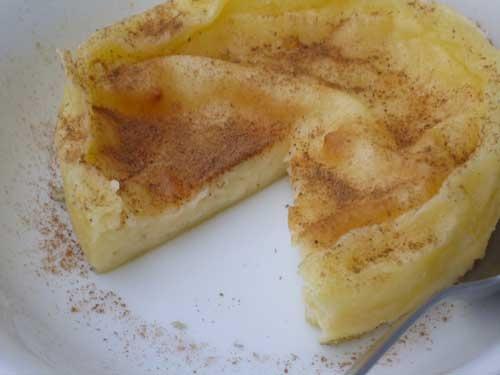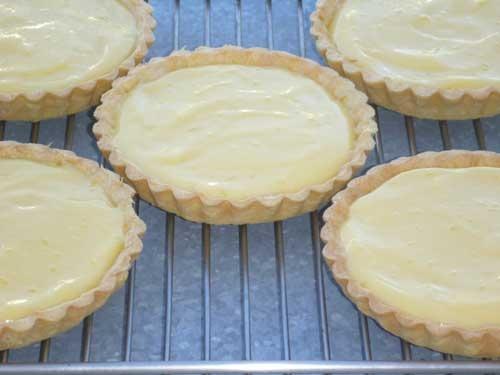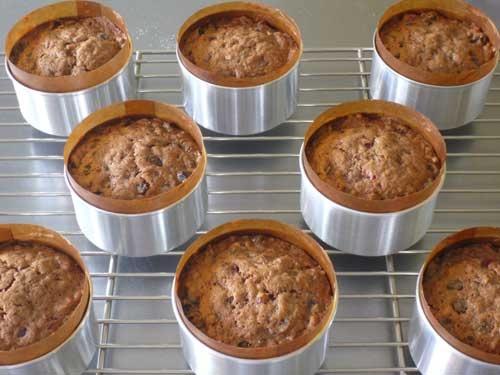-
Posts
542 -
Joined
-
Last visited
Content Type
Profiles
Forums
Store
Help Articles
Everything posted by JohnT
-
I am not a cheesecake fan, but have ordered a slice in various restaurants when I have been in the US. All were very dense and most were too sweet for me. All, with the exception of one, had slightly browned tops (of which a number had this "disguised" with a topping added). All, with the exception of the same one as above, had a crumb base. The exception was one I had in Fort Lauderdale. It was also dense, but had no cracker base and the top was not brown nor coated. I asked the owner of the restaurant what happened to the crumb base and he told me that a proper NY cheesecake was never made with a crumb base. If this was true or not, I never found out. Earlier this year I searched the Internet for a good recipe and came up with a few, which I tried. All were too dense for my liking and a few had a grainy mouth-feel. So, I did another search and found a recipe that worked for me. The author also says that a true NY cheesecake should have no crumb base but does add one to his cake once it has chilled after baking. Have a look here http://www.joepastry.com/category/pastry/cheesecake/new-york-cheesecake/
-
Hi jmacnaughtan, thanks for your advice. As you may realise from the sweets thread, I am changing a lot of the traditional ways I have been doing things when it comes to desserts. The only thing I have used ring molds for in the past was to stack plated meals, never desserts. So this is something a bit new to me. Your method makes sense but I will have to make quite a few adjustments in my methods to "get it right". I actually made a batch of my cheesecakes yesterday and had just finished stacking everything in the ring molds when my heart sank - I forgot to put in the acetate linings. Well, I have a bunch of them that are now being snacked by my employees family! Oh, and as mentioned in the sweets thread, I am making quite a lot of your sweet pastry, which is so quick and easy and really is tasty and versatile. I now need to make a test batch with cocoa to have a chocolate version for my rich chocolate mini tarts. Regarding the acetate, it is not available here as pre-cut. This is Africa and we have to find sheets of acetate and have somebody cut it or do it yourself. Fortunately, I had a pile of A4 sized sheets I had from a previous project and am experimenting with that before I get a whole batch cut at a plastic supply company. John
-
Thanks for that. I just wanted to confirm what I thought before messing up a batch of cheesecake. And yes, it gets frozen in the mold. I have two thicknesses of acetate - the thin one is not stable enough but another I have seems to be thick enough to not collapse in the ring. Will give it a try and see what happens. Was also thinking of a ultra-thin coating of sunflower oil on the acetate to help release, but thought it may taint or affect the product. John.
-
Time to revive this old thread. I am going to make a few different desserts in small ring molds - the molds are 6cm and 7cm diameter. I have found an acetate which I cut so that is about 1cm above the ring when inserted and overlaps about 2cm inside the ring. One of the first experiments is to do small cheesecakes using a crumbed biscuit and butter base about 5mm in height and then the cake part that has both melted white chocolate and a touch of gelatine in it to keep stability. Anybody have experience in doing this? My real question is: should I use some kind of lubricant on the inside of the mold and also on the inside surface of the acetate to help in a clean removal once the contents have been removed from the ring and I want to remove the acetate? I really want to get a clean removal of the acetate without damage to the dessert. John
-

Your Daily Sweets: What are you making and baking? (2014)
JohnT replied to a topic in Pastry & Baking
SINGLE QUANTITY MELKTERT Makes: 1 x 23cm single or 9 x 8cm mini tarts Ingredients: Crust: 20g salted butter 5ml sugar 1/3 large egg 60g cake flour 1.5ml baking powder 3.5ml salt 20 ml fresh full cream milk Filling: 45g cake flour 30g cornflour 100g sugar 1 ml salt 500ml fresh full cream milk 1.5 extra large egg, separated 85g unsalted butter ground cinnamon, for decoration Method: Preheat oven to 180°C (160°C for fan oven) For Crust: Cream the butter and sugar together until light and creamy, add the egg and beat well. Sift the dry ingredients together and add to the egg mixture and mix well. Gradually add the milk to the mixture until a spreadable consistency. Spread with the back of a spoon onto the sides and base of the tart pan(s). -------------------------------------------------------------------------------------------- For Filling: Sift the dry ingredients together. Mix with some of the milk to a smooth paste. Heat the remaining milk in a heavy-based saucepan until boiling point. Beat the egg yolks and add to the flour mixture, mix with some of the hot milk until smooth and gradually add to the remaining milk. Stir continuously over a moderate heat for 4 - 5 minutes, add the butter. Remove from heat and allow to cool slightly. Beat the egg white until soft peaks and lightly fold into the milk mixture. Divide the filling between the prepared crusts and spread evenly. Bake for 10 to 13 minutes or until set and light golden in colour. Sprinkle with cinnamon and serve warm or at room temperature. Source: Prof. Elain Vlok Note 1: Traditionally the melktert filling is cooked with a large slice of naatjie peel in it and removed just before pouring into the tin. I skip doing this as I cannot discern any flavour difference in the result - my taste buds are old and decrepit. Note 2: The above recipe is my scaled down one. If anybody wants the original for 6 x large tarts, just send me a PM and I will send it off and you can do the scaling up or down yourself. Note 3: The original recipe used a mixture of self-raising and cake flour in the crust - I have adapted it to use only cake flour and thus the salt quantity is important. Note 4: We only have cake flour and bread flour in South Africa, but I think our cake flour is pretty close to the US AP flour. These tart are very common in South Africa and are served more with a cup of tea or coffee than as a dessert after a meal. Enjoy - John. -

Your Daily Sweets: What are you making and baking? (2014)
JohnT replied to a topic in Pastry & Baking
Anna, the "Melktert" is Afrikaans (a language derived mostly out of Dutch) for "milk tart" and was originally a simple but tasty tart used by the Dutch farmers of the 1700's in what was called the Cape Colony, now South Africa. There are many recipes for it on the Internet, but most use a pastry shell, which was not used in the old days. My recipe comes from a Professor at one of universities here, who has a BSc in Home Economics, and is basically a crustless one - it uses a paste for the crust, which is paper thin when cooked with the tart. The original recipe from her is for six 23cm tarts (or 50 of my 8cm ones), which I adapted slightly. I have also scaled the recipe down to make one 23cm (or 9 x 8cm ones). Is really is a tasty custard that sets. If anybody is interested, I can post the recipe. The creamed lemon curd is a recipe I was given by a Swiss pastry chef who took me under his wing in the mid 70's - he taught me how to bake and make some really great desserts. I found it in an old folder the other day when going through some of my files - it nearly ended up being thrown away! It is a basic lemon curd (lemons off my tree in the garden) to which you whisk in quite a lot of butter once it has cooled to about 60°C. It fluffs the curd up a bit and adds that extra "touch" and mouth-feel to the curd. It also holds its own when cut. The pate sucrée recipe I now use was one posted by "jmacnaughtan" on eG and beats the recipe I originally used from my mentor. It really is simple and good! John -

Your Daily Sweets: What are you making and baking? (2014)
JohnT replied to a topic in Pastry & Baking
I am into making single or small portion desserts at the moment. Here are a few experiments this week with a few still in the experimenting stage and thus not shown here. This is a single portion "Melktert", a traditional South African tart made mainly with milk. It is made in a round 8cm pan These are 12cm diameter diameter lemon tarts made with a pate sucrée base. The filling is "creamed" lemon curd. And with Christmas just around the corner, the first batch of mini Christmas cakes - well laced with brandy to "preserve" them. They are 10cm diameter and 5cm in height. -
Just my uneducated guess is that there was a sub of baking powder for soda. I have never made donuts but have made a similar product where I inadvertently used BP in place of soda and had a similar reaction in the fryer.
-
Thanks for that link. It was one I actually found on Google but thought the cream topping did not sound correct. However, it has given me an idea which I hope to develope over the next week or two with a bit of experimentation. heidih, no, it has no vegan issue. However, the catering company requests that I keep is as close to Halaal as possible due to their client base. It is not claimed to be Halaal but they want no gelatine used that is derived from animals. They have given me a few names of substitute products to use if gelatine is needed. Thanks for some enlightenment on how they should look. I have been doing quite a bit of reading on these pies over the past two days and am thinking of something a bit off the beaten track. I have been contemplating using a thin nutty (chopped walnuts?) brownie type base instead of the usual Graham cracker type base. Then a thick chocolate-hazelnut mousse layer topped with a chocolate ganache layer and sprinkled with some Mississippi River gravel (a thin sprinkle of chopped nuts again). I will play with this for a bit and see how it turns out and post a pic or two in the next few weeks. I am a bit pushed for time at the moment having just arrived back in the kitchen after a month traveling and have a massive backlog to catch up with.Thank for the responses - any further comments will be appreciated.
-
I have been asked to make individual Mississippi Mud Pies for a catering company and have been doing some Internet searching on the subject. Firstly, MMP's are not very well known in South Africa and I have never seen one or tasted one, so I thought Google was my friend. Well, I have found so many different desserts called MMP's that are so different and varied that I still have no idea what a MMP should look and taste like. I did an eG search as well and came across many mentions of this dessert, but no recipes. Can anybody give me a few pointers or point me to a recipe or two for me to get aquatinted with this "pie". Just for a bit of extra info, the request is for individual portioned pies made in 70mm (D) x 50mm (H) ring moulds. Any gelatine used must also not be animal derived. The pies can be frozen and should have a shelf life of around 5 days once defrosted or from fresh, if not frozen. Any help will be greatly appreciated. John.
-
Ha, I had three of them in the mid 60's - fine, medium and rough. Never touched any food with them as they were for shaping surfboards. And I still have no need for them as my standard box grater does just fine, than you!
-
In 1993 I went sailing with a German gentleman who had a good chuckle when I told him how I cooked a pork shanks - long slow roast for 4+ hours. He came from Bremen and said I was wasting my time, telling me that they simply put the shanks into a big pot of water with an onion quartered, a chopped carrot, a teaspoon of peppercorns and a few bay leaves. Do not score the skin. Bring to a simmer and boil them for 2 hours then remove them and very gently score the skin and rub with salt. Stand on end on a grid in a pan and cook in a hot oven (I use 220C) for half an hour to crisp the skin. Although the skin feels soft when still in the oven, it crisps nicely as soon as the shanks are removed from the oven. Serve with sauerkraut, a few boiled potatoes, German mustard and a good dollop of apple sauce on the side. I have done them this way ever since. Magic!
-
I have never taken humidity into consideration when making pastry or batter for cakes - I do not make huge batches. However, when making bread dough I go for the correct weights in my formulars and sometimes find the flour does not absorb as much water as on a previous batch. This is when the hands tell the brain that a bit more flour is needed to get the correct "feel", which takes a bit of time and experience. When I first started baking in 1976, my Swiss mentor told me to make my dough "wetter" to get a good rise and crumb - he kept on about hydration percentages, which took me some time to realise what he was on about. His English was not very good. But I did learn with his hands-on approach. I enjoy bread baking but only do pretty basic breads for a couple of restaurants - more dinner rolls than loaves. A couple of years ago I went for some schooling on more artisanal baking and was given a book by Daniel T. DiMuzio as part of my instruction. It really opened my perspective and is a brilliant book for both amateur and professional bakers.
-
The link provided by Kim Shook appears to be a very good one that can be done well before the wedding and adapted to your "fit on a stick" thought. However, you can also change it to be marinated in a light lime dressing and then served on small skewers. Although it may not be appropriate to do in bulk, mini bruschetta platters may be a thought. Then also think along the lines of sushi - easy to do in advance.
-
How many mouths do you need to feed?
-
This is quite an interesting discussion, and I include the slight deviations off topic. Reading a recipe that has measurements in cups is actually quite difficult due to the different definitions of a cup in different locations around the world. For instance, a cup in America is defined as 8 fluid ounces, which is equal to 236ml (as close as necessary for this discussion). However, a metric cup is defined as 250ml. Then we had (still have?) the Imperial cup, which is defined as 284ml. So, I have a recipe that I know comes from the US and thus I can figure out how to convert it to weight. I can also get an old recipe book and see that it originated in the UK, and be able to convert to weight. But, we have this fantastic electronic system called the Internet, which is helping screw up recipes. Let me take an example. A food magazine hires a couple of "graphic artists", fresh out of collage. These kids are good in what they do and can manipulate and mockup great looking pages in a magazine, with a couple clicks of a mouse. So, I tell them that they need to get me two recipes each for chocolate cakes. And off they go and search the Internet and return with a couple recipes each, together with a bunch of shutterstock photographs. Does the magazine actually test all the recipes? Actually, most appear not to. They may do one or two to get some good photographs. Have the recipes been converted - I mean the recipes may have come from a French site using metric cups and the youngster (who may not even know how to boil an egg, never mind bake a cake), does not know that the size of an American cup is smaller than a metric cup. You then come along and think the recipe sounds great and bake the cake and it is a flop. Shel_B state up thread: Maybe the difference in the weights in these recipes was due to the source of the recipes - some from the US, Canada, England, France, Australia, etc. and the writer of the recipe did the conversion using the known cup size used in that country and actually tested the recipes.What I am rambling on about, is that the source of a recipe needs to be taken into consideration when converting a "cup" to weight. Also, Lisa Shock's comment is spot on: It really is high time that all publications of recipes publish by weight, and preferably using the metric system. All publications I come across out of the US that are for the professional chef are in metric weight, and have been for as long as I can remember. A kitchen scale is, in this day and age, a necessity in every kitchen. Publishers, especially in the US, need to get "with it" and evolve with worldwide trends.So, to get back to the topic heading, measuring flour, the quantity and thus the weight of a cup of flour depends on where the recipe originally comes from. And just to add a bit of humour, I assisted in a "test kitchen" for a magazine once where I was presented with a recipe for a wonderful chocolate almond tort. I baked the tort and the centre sunk when it cooled. It was pretty bad, but the magazine had their photographer there and when I was going to dump the tort I was told to stand aside and let the presentation team take over. I still remember the photograph of the absolutely wonderfully smooth ganache covered cake appearing in the publication, knowing that the centre contained a wad of crumpled toilet paper to prevent the weight of the ganache covered cardboard disk from sinking. I later found the original recipe for the tort and did the correct conversions to weight and still use it today. It was originally in cups and the young lady who "converted" it used the incorrect cup sizes and thought almond flour weighed the same as cake flour.
-

Your Daily Sweets: What are you making and baking? (2014)
JohnT replied to a topic in Pastry & Baking
Your pâte sucrée looks brilliant (the whole tart does!) - mind sharing the pâte sucrée recipe or pointing to it? -
Paxu, a few questions. Do you make the patties yourself or are they made by some other company? I ask this as, if I was making the patties, I would season the meat just before grinding then after grinding form and freeze the patties. In this way you only have to baste the patties when grilling. I do not know your methods but when I make a batch of burger patties (which is not very often), I make it from scratch and add the seasoning to the meat before grinding. By seasoning I am talking about herbs, onion and a bit of pepper - never salt. It is then evenly incorporated in the ground meat during the grinding process. I never add raw salt to the meat before, during or after cooking as this is left to the individual to do to their taste. Saying this, when I do burgers, they are always flame grilled with a basting sauce, which contains soy sauce and thus sufficient salt - if the client wants to add more, they are free to do so by including salt and pepper sachets with the burger or at the table. It is far easier to have a standard patty and incorporate the salt and other flavours into the product via the baste. You can then have a few different bastes for beef, chicken etc., where the extra flavours and flavour enhancers are incorporated into the product during grilling.
-
They look a bit like a young piquante pepper, except for their colour. The piquante pepper is an orange to red colour and is pickled to use on a salad. It is sold under the registered trade name "Pepperdew". How hot are these ones? And how do you use them?
-
Shel_B, when you talk about a drop biscuit, are you talking about something like an English Muffin? If so, I found this recipe a time back and it works brilliantly: http://shesimmers.com/2009/03/homemade-english-muffins-complete-with-nooks-and-crannies.html
-
Have you had a look at http://www.veganbaking.net/recipes/pastries
-
Halal beef "bacon" is called Macon in South Africa.
-
That looks oh, soooooo good!
-
Ah, thanks for that - learnt something new today. We just call them garlic flower stalks, but you do not find them for sale in the markets or shops here and I have never thought of cooking any from the few garlic plants that I have grown. I have just put them in the compost heap!
-
Excuse my ignorance, but what are garlic scapes?





